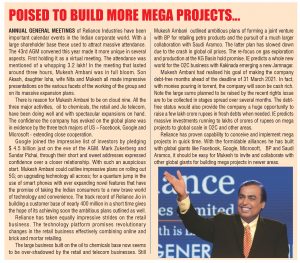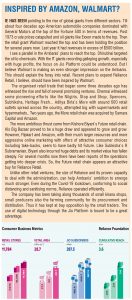“Dhirubhai is not in the pink of his health. The stroke he suffered a couple of years ago appears to have caused partial paralysis of his right arm. As he was getting down the platform after the press conference was over, leaning on the shoulders of chief executive Malhotra, the latter tripped and fell down. Malhotra’s nose was bleeding profusely; he quipped: in over two weeks of hectic, almost the round-the-clock rehabilitation work of the flood-ravaged plants done on a war footing, I didn’t suffer even a scratch. But a relaxed and tension-free routine has its hassles!” (IE, Sept 1989 issue)
The occasion was the end of the press meet at Patalaganga plant of Reliance Industries in July 1989 addressed by Chairman Dhirubhai Ambani. It was a momentous meet in which nearly a hundred media persons were assembled (including this writer) from all over India to demonstrate that Reliance was not just alive and kicking but was much fitter than earlier and ready for further quantum leaps.
That was necessitated by the media campaign led by Indian Express’ Ramnath Goenka. His chelas, Arun Shourie and S Gurumurthy, were waging a strong and virulent battle pointing to the shenanigans of Dhirubhai and were humming the swansong for RIL. I recalled the reason for their conclusion.
“The flash floods at the Patalaganga river submerged the entire RIL plant to a depth of a metre to two of water. At the warehouse hundreds of bales of polyester staple fibre (PSF) and crates of polyester staple yarn (PSY) floated around. An audio-visual provided a glimpse of the devastation. It also showed the resilience of Reliance to cope with the situation and get back to normalcy in quick time.” (IE September 1989).
Most sections of media believed that the devastation caused by the flash floods to RIL’s Patalaganga plant had sounded the death knell for Reliance.
“In a visit around the plant one could see production going in full swing. We found the maximum water level on the night of 23 July marked at the different areas we visited. These must have caused considerable damage, particularly to the sophisticated instrumentation systems, with their intricate cable network (it is gathered some 1162 km of cables ran across the complex). I could see hundreds of bales of damaged fibre stacked along the road.” (IE September 1989.)
Reliance had L&T at hand…
Remember at that time Larsen & Toubro was part of Reliance. The rich resources available with L&T in project constuction and management was ready at hand. Dhirubahi mobilised, in a remarkably short time, 2000 of L&T’s skilled workers, engineers and senior executives. “In less than 96 hours some 6200 were mobilised. By 26 July 1 MW of power for taking care of the massive requirements of revamping the plant was in position.”
Look at the speed of action: “Telephone communication was restored in less than three days and fax in four days. The utilities started operating normally within 8 to 12 days. The PSY and PSF plants that suffered most were ready for operation within two weeks and in the next five days the entire complex began operation in full swing.”
“The genius of Dhirubhai lay in turning such an adversity into an opportunity, to refurbish and upgrade the facilities and Reliance never looked back since.” (IE September 1989.)
(In a separate article on the fall of Binnys I had contrasted such a flood proving fatal. Binny ended as a great name in industrial strifes and real estate.)
The ability of Dhirubhai to manage likewise policymakers, the media and other sections of opinion makers was at the base of much of his success during the licence-permit-quota raj. The economy opened up for competition in 1991, not just within the country; with the advent of the World Trade Organisation, several companies including MNCs, that were successful till then, folded up or quit India. The southern petrochemical giant SPIC easily comes to mind: after more than a decade of strident growth and diversification, the company’s fortunes declined. Even American chemical giants like DuPont and Chevron opted to quit.
Three decades of liberalisation under different governments at the Centre, Maharashtra and Gujarat witnessed Reliance emerging stronger by the day. After Patalaganga, Reliance expanded massively at Hazira and Jamnagar in Gujarat and also invested thousands of crores in offshore gas and oilfields at the Krishna-Godavari Basin off Kakinada in AP. The focus continued to be on oil to chemicals and petrochemicals with integration of facilities through refining, exploration and production.
In 2009 RIL’s gas production peaked – to over 60 msmcmd!
The silent but strong work on exploration on which around Rs 30,000 crore was spent, showed great promise. Murli Deora, then Minister of Oil and Natural Gas, told economic editors in 2009 that the KG fields were producing more than 60 million standard metric cubic metres of gas per day (msmcmd) and expressed confidence over this expanding to even 200 msmcmd over the next couple of years. At that point of time only Reliance was so active in the production of gas at the KG Basin; ONGC, Cairn and Gujarat Petrochem were still struggling to begin production. Reliance had ambitious plans to use the gas at its own large-sized fertilizer and electricity generation plants in Navi Mumbai. But with the decline in gas production, the decision of the government to allot the gas for fertilizer and power producers on its own and the uneconomic price of $4.20 per 1000 MBU resulted in the Ambanis shifting their attention to Jamnagar.
Action shifts to Jamnagar…
Reliance set up initially a 30 million tonne world class and global size refinery and soon doubled capacity to 60 million tonnes. In a visit to Jamnagar in 2006 I was struck by the spectacular transformation of this once arid coastal town of Gujarat. The entire crude was imported and port facilities were created to handle around 130 million tonnes for both import of crude and export of petroleum products (The port handled more volume than the three major ports of Tamil Nadu put together!). The government denied private oil companies, Reliance and Essar, subsidies on petrol and diesel to compensate the loss suffered on administered prices.Reliance opted for 100 per cent export of its products. The company built handsome refining margins and made the exports so profitable! Even while crude imports accounted for the largest share of the country’s imports, thanks to Reliance, petroleum product exports formed the largest component of India’s exports!
Yet another sight at Jamnagar made a deep impression on me: over 100,000 mango trees so beautifully ‘manicured’ – pruned to a height of around 8 ft. There was application of high technology by horticulture experts drawn from the agricultural universities of Maharashtra. Copious availability of water, thanks to desalination of sea water turned that area with scanty rains into lush green orchards. I guessed the success in exporting mangoes to profit to Harrods, London, provided the impetus to Reliance’ diversification to retail business. (A small personal note: during 2004-08 Reliance Industries was a tenant at Economist House and the Reliance Retail business was taking shape at Guindy.)

Mukesh Ambani is credited for these profitable diversifications. His US-educated children who belong to the digital generation, had a ringside view of the spectacular application of internet, communication and telecom technologies. This should be of help in triggering the launch of the Jio Platform. Quite appropriately the gen-next Ambanis, Isha and Akash, occupied the centre stage at the recent AGM. The nearly three hour meeting was fully occupied by the family quartet: Isha, Akash, Nita and Mukesh Ambani. I am sure the fifth one, Anant Ambani, would soon make it the Pandavas of today’s Mahabharat.
From history, look at the exciting possibilities for the future of Reliance. At the AGM Mukesh Ambani and his team so beautifully highlighted the thrust of all the three major activities of oil to chemicals, retail and Jio. In this the company has already impressed the top tech leaders in the field of IT in the US – Facebook, Google and Microsoft along with QualComm, Intel… Just think of Sundar Pichai and Mark Zukerberg making presentations at the AGM and Satya Nadella spending so much of his time with Mukesh Ambani during his recent visit!
Retail also poised for drawing funds…
The massive flow of money into the Jio Platform appears the beginning. Mukesh hinted at plans for such opening up also for the oil and retail businesses. BP has already made handsome investments in the O2C business and Saudi Aramco seems to
Kakinada can be the new Jamnagar
In May issue IE has pointed to the Mukesh meeting with AP Chief Minister Jagan Reddy as far more significant than just getting a Rajya Sabha seat for RIL President Parimal Nathwani. I foresee Kakinada emerging another large Reliance centre after Patalaganga, Hazira and Jamnagar. Reliance has invested in the last two decades more than Rs 30,000 crore on the K G Basin offshore gas fields. With the promise of the KG-D6 gas field commencing production soon, there are expectations of copious availability of natural gas. It should be a very rich source for large capacity petrochemical, fertilizer and power generation units at Kakinada and its neighbourhood.
After bifurcation, AP is in dire need of mega investments which southern businesses are wary of making. With the predominant
majority enjoyed by his party (151 out of 175 seats in the A P Assembly), Jagan Reddy is in a position to offer large land areas for mega projects (a prospect not available with other southern coastal states of Kerala and Tamil Nadu where land is scarce and expensive). AP is also fertile with two perennial rivers, Krishna and Godavari.
RIL can raise over Rs 4 lakh crore in debt!
Reliance becoming free from debt and the massive size of its balance sheet vests it with a huge leverage. It is now be possible to raise more than Rs 400,000 crore for new investments through fresh debt. Such leverage enabled Reliance in the past to foray into mega projects at Jamnagar as also for Retail and Jio. Today it has the added advantage of raising resources through rights issue with a hefty premium as also by offloading a portion of capital to international investors. The recent rush of over a dozen global companies from Facebook to Google to invest in the Jio Platform is surely a confidence booster for this possibility.
Yet another aspect of Reliance evolution appears unique. The very many difficulties of doing business in India, often complained by entrepreneurs, had resulted in driving ambitious entrepreneurs and enterprises to greener pastures outside India. This migration began in the decades of licence, permit and quota raj prior to 1991. We had witnessed the Birlas, the Tatas, the Swraj Pauls, the Mittals, the Hindujas, the Agarwals and dozens of medium and smaller enterprises building fortunes outside India. But Ambanis have been focusing their energies on India and seizing opportunities offered by the huge market. Their success now in attracting the large icons of US, Middle-East… should be music to the ears of atmanirbhar advocates.
I am sure Gurumurthy who was once among the strongest critics of the Ambanis should now be impressed with this commitment to swadeshi spirit by the very Ambanis.
Tough task of making 5G India…
Ambani is confident of selling 5G technology in global markets like the US, Australia, Japan, Europe and the UK and also making India self-reliant.
In the year 2012, a quarterly video conference of executives of the largest private sector company of India commenced with a word of caution. The chairman of the company said: “what has brought us here will not take us to the future.” Due to mounting global trade tautness and strong push for renewable energy he was fretful that the company’s bastion business of crude oil refining and petrochemicals could lose polish. Although his father, the founder of the entity, wanted to compete with the international energy super titans, the son was quick to comprehend that ‘Data is the new oil’ and began the diversification of the company.
Yes, he is none other than Mukesh Ambani, the chairman of the largest private sector company of India, Reliance Industries Ltd [RIL].

Ambani had planned to acquire Infotel Broadband Ltd in 2010. However, daughter Isha’s criticism when she was home from Yale University for a holiday, of pathetic broadband speeds in India, gave birth to a revolutionary wave in his mind. Ambani swiftly realised that digital technology is the newfangled super-highway to mammoth accomplishment and took four years to launch Reliance Jio in September 2016. At
present, it is India’s biggest network with about 40 crore 4G subscribers. It has become Reliance’s evolution engine, blending with the entity’s fast-growing retail arm to help counterbalance the decline in oil and petrochemicals growth. Jio has built world-class capabilities in technologies such as 4G, Cloud computing, Devices and OS, Big Data, AI, AR/VR, Block-chain, Natural Language Understanding, Computer Vision…
In 2014 Ambani’s twin children, Isha and Akash, joined the Reliance Jio and Reliance Retail boards. Mukesh gave only four days break to elder son Akash after his graduation to join the organisation. A little late, the youngest son, Anant joined the team at the top. Akash crowns strategy and leads procurements along with Isha, who is part of branding and marketing.
Disruptive growth strategy again
Mukesh is known for disrupting the numerous business sectors and models. Four years ago, in 2016, when he proposed 4G Volte smartphones under Reliance’s own brand name Lyf at an attractive and economical price of Rs 2999, there was scepticism. Of late, during the company’s first virtual annual general meeting, Ambani charted another visualisation to disrupt the mobile marketplace again.
Ambani announced Reliance will be a contender with its own 5G network solution. Having invented a remedy from scratch, he is in a mood to crack now. With this technological change of building a virtualised 5G network, existing hardware-dependent networks can be budged to software-centric podiums. This will also significantly reduce network costs. According to software entity Mavenir, 40 per cent saving can be done in capex and 34 per cent saving can be achieved in operational costs in the new virtualised networks.
Reliance placidly started work of building Generation Z network in 2018 by acquiring US-based Radisys. Reliance through its subsidiary Rancore Technologies, now amalgamated with Jio, was crafting its telecom research and development design. Few months ago, it has also approached the Central government for permission for 5G trials.
His cost advantage for 5G
Now Google said hum saath saath hain and showed interest to invest in Jio Platforms. Numerous plans have been drafted by both Reliance and Google to make India ‘2G mukt.’ Like cherry on cake, many international players such as Facebook, Silver Lake partners, Vista Equity Partners, General Atlantic, KKR, Mubadala, ADIA, TPG, LCatterton, PIF, Intel and Qualcomm have joined the Reliance as investors and strategic partners. Altogether Jio has raised Rs152,055.45 crore from these fabulous fourteen financial partners. Majority of them are part of the Open RAN Policy Coalition which was set up in May 2020 to support 5G technology. Reliance is also a member of the coalition and Ambani mentioned that 5G network is ready for experiments once spectrum is accessible.
Tough task…
Although with the billions of dollars he has raised, the richest man of India has decided to step into the technology cold war, his plan of designing the 5G network has its problems. His speech at the AGM was sprinkled with customary catchwords including dedication of 5G solutions to Prime Minister of India’s Atmanirbhar vision. He called the technology a “Huawei-killer” and mentioned that US State Secretary Mike Pompeo proclaimed Jio for not using the Chinese flavour.
Launching of 5G is very expensive as shown by the roll out of 4G. Again, 5G cannot be launched at one shot and has to be in a phased manner. Premium consumers should be wooed first.
The strategies to manage traffic patterns, pollution levels, electricity grids are vague. In addition, Huawei of China holds the most patents in the world and many Chinese and Korean companies already control the largest number of such patents. Numerous entities including Samsung have commenced the task on 5G technology long ago. Ambani’s plan of action looks tough.
British telecom companies have been granted seven years from now to rip out Huawei equipment from their networks. A long time has been granted by British Prime Minister Boris Johnson considering the capital costs of shorter duration and probable blackout of their networks. For a telecom company with only four year track record and with no substantial patents, establishment of complete home-grown 5G network is a gargantuan task.
Need for supportive infrastructure…
Although Ambani and his friends who are Indian policymakers are ambitious about the new venture, overall infrastructure is not supportive. Everyone is hoping for fiscal sops from the government. Operators in India are doubtful to buy their network from an entity which is a rival in services. Furthermore, there is a lesson for Reliance: the biggest operator in the United States of America, Verizon, promised high speed data to its consumers and eventually failed in the compliance with the standards laid down. Later, the company adopted a lower technology norm which is not a comprehensive 5G network.
Reality of the virtualised network…
Plan of launching 5G network by the Japanese E-commerce player Rakuten is also in the news. Though it is a good news that the virtualised network is reality, Reliance will face tough challenge from Rakuten. The Japanese company is already ahead in the battle and approached Dish Wireless to sell its mobile network in the United States of America. Surprisingly, the key person who played a vital role in Jio’s 5G network business blueprint joined Rakuten as chief technology officer.
To conclude, in the 5G world, telecom operators need to step outside the zone of connectivity and team up with manifold patrons across sectors – finance, transport, retail and healthcare – to deliver groundbreaking digital services and amenities. More importantly, in 5G the value chain is very complex and multifarious. Even though, Jio took a big leap and approached the Department of Telecommunications for assigning 5G spectrum, the government’s imminent auction process might be limited to only 4G spectrum. While ambitious Ambani is confident of selling 5G technology in global markets like the US, Australia, Japan, Europe and the UK and is sure of making India self-reliant, many questions remain unanswered. The richest man of India has to invent rich measures to make 5G India. Only then he can say cheers with Jio Glass. With his track record he appears capable of saying this soon. -Shivanand Pandit



